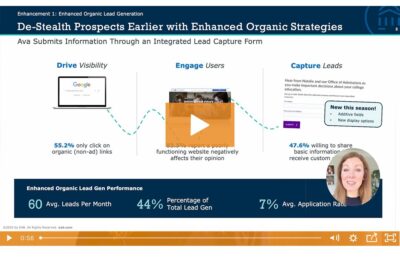Building an Effective Graduate Enrollment Management Plan
While the past 20 years have been a time of rapid expansion for graduate enrollment, that growth has not been consistent or easily won.
Just as it is imperative to have an enrollment management plan at the undergraduate level, the graduate enrollment landscape’s continual evolution necessitates developing a graduate enrollment management (GEM) plan.
This study explores the need for a graduate enrollment management plan and the framework and elements of an effective graduate enrollment management plan. Download the study as a PDF, or explore the highlights below.
Effective enrollment management is key to stability and growth
Enrollment management has a long and storied history in the United States, dating back to 1636 with the founding of Harvard College. Over the past 386 years, enrollments have been influenced by public policy, changing demographics, world wars, recessions, new competitors, and most recently, pandemics.
But the need to effectively manage enrollments has become more important than ever. The way that higher education responds to these internal and external forces, specifically at the graduate level, will be the difference between strategic growth or no growth at all.
Historical changes in graduate enrollment
Year-over-year growth of total graduate enrollments–all four-year institutions, NCES 2000-2021

More on the Need For a GEM Plan
The core of a strong graduate enrollment management plan is a clear mission
A GEM plan is not just about solidifying enrollments and revenue; it’s about making the right decision on how an organization needs to compete in the marketplace. According to Uhl (1983), effective strategic planning depends on:
- An internal and external analysis
- The development of a mission, vision, and goals
- Creating objectives and action plans
- Examining how resources will be utilized within the plan
These inputs, which rely on relevant, accurate, credible, timely, and persuasive data, shape the measurable objectives of the graduate enrollment management plan.
More on Foundations For a GEM Plan
The six elements of a graduate enrollment management plan
The foundation of a GEM plan must include the vision, mission, strategic initiatives, data from internal and external environmental scans, and alignment to specific accreditation and programmatic accreditation standards. From there, utilization of the relevant, accurate, credible, timely, and persuasive data is what shapes the measurable goals and objectives of the GEM plan.
Learn more about each of the following elements:
- Internal and External Environmental Scan
- Program Development
- Marketing and Recruitment
- Tuition and Financial Aid
- Student Success and Retention
- Faculty and Resources
More Resources

Achieving Today’s Ever-Growing Graduate Enrollment Goals

Understanding and Navigating Today's Graduate Enrollment Staffing Concerns
